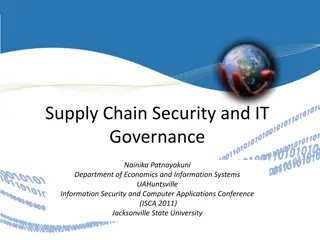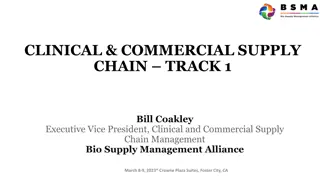The Art and Science of Demand and Supply Chain Planning: Navigating Today's Global Economy
Explore the intricacies of demand and supply chain planning in the modern global economy through the insightful content provided in this book. From achieving supply and demand balance to adapting to uncertainties like navigating white water rapids, the text delves into strategies for improving accuracy, timing, and flexibility in supply chains. Understand the historical perspective of supply chains and learn how to develop a sustainable competitive advantage through effective supply chain strategies.
Download Presentation

Please find below an Image/Link to download the presentation.
The content on the website is provided AS IS for your information and personal use only. It may not be sold, licensed, or shared on other websites without obtaining consent from the author.If you encounter any issues during the download, it is possible that the publisher has removed the file from their server.
You are allowed to download the files provided on this website for personal or commercial use, subject to the condition that they are used lawfully. All files are the property of their respective owners.
The content on the website is provided AS IS for your information and personal use only. It may not be sold, licensed, or shared on other websites without obtaining consent from the author.
E N D
Presentation Transcript
The Art and Science of Demand and Supply Chain Planning in Today's Complex, Uncertain Global Economy By Paul A. Myerson
SECTION I Introduction to Demand and Supply Chain Planning in Today s Complex and Increasingly Uncertain Global Economy
CHAPTER 1: Introduction to Demand and Supply chain Planning in today s complex and increasingly uncertain Global Economy
Supply and Demand Balance and Harmonization Allowing the people, process and technology of demand and supply planning to all work together in unison for a lean, agile supply chain.
White Water Rapids Organizations exist in an environment today that lacks stability and predictability, requiring flexibility from the processes, technology, and people in the supply chain to navigate these rough waters.
Where to Look for Improvement: On the Demand Side Improving Timing and Accuracy Flattening Volatility Enabling Accurate Forecasts
Where to Look for Improvement: On the Supply Side Supply-side accuracy and timeliness People, Process, Technology
CHAPTER 2: Understanding the Importance of Supply Chain to an Organization and Developing a Strategy for a Sustained Competitive Advantage
Supply Chain: Historical Perspective Pre-WWII Post-WWII 1960-1980 1980-1999 21st Century
Value as a Utility Form Utility Time Utility Place Utility Possession Utility Information Utility Service Utility
Corporate, Business and Supply Chain Strategy Mission and Vision Statements Strategy Defined Determining your Corporate and Business Strategy Strategic Choices
Supply Chain Objective and Strategic Importance Supply Chain Surplus = Customer Value - Supply Chain Cost.
Supply Chain Strategy Transformation Methodology 1. Start with customers' current and future needs 2. Assess current supply chain capabilities relative to best in class 3. Evaluate supply chain "game changers" 4. Analyze the competition 5. Survey technology 6. Deal with supply chain risk
Supply Chain Strategy Transformation Methodology (cont d) 7. Develop new supply chain capability requirements and create a plan to get there 8. Evaluate current supply chain organizational structure, people, and metrics 9. Develop a business case and get buy-in
Supply Chain Strategy Implementation Methodology
Supply Chain Strategy from a People, Process and Technology Standpoint
Chapter 3: Supply Chain Performance: Achieving Strategic Fit and Scope
Supply Chain Drivers and their Impact on its Capabilities
Achieving Strategic Fit Step 1 Understanding the customer and supply chain uncertainty
Achieving Strategic Fit Step 2 Understanding the supply chain
Achieving Strategic Fit Step 3 Achieving strategic fit
CHAPTER 4 Supply Chain Metrics and Measurements
Evolution of Metrics 1. Focus on manufacturing costs as a measure of efficiency 2. Broader performance of distribution and logistics costs 3. The internet and ERP systems allow organizations to take an even broader view of both their extended supply chains and more easily gather, measure and analyze cost and service information. 4. Data Analytics
Data Analytics Descriptive Diagnostic Predictive Prescriptive
Measurement Methods The Balanced Scorecard The Supply Chain Council s SCOR Model Activity-based costing (ABC) Economic value analysis (EVA)
Measurement Categories Time Quality Cost
Supply Chain Operations Reference (SCOR) Model
Indicators 1.Leading indicators 2.Lagging indicators 3.Diagnostic
Benchmarking Defined: once you have established what KPI s to measure, you need to determine how to gauge yourself against them. Benchmarking Process: 1. Determine what to benchmark 2. Form a benchmark team 3. Identify benchmarking partners 4. Collect and analyze benchmarking information
Chapter 5: Supply Chain Network Design
Supply Chain Network Design Influencers Lead time Product variety Product availability Customer experience Time to market Order visibility Return-ability
Types of Tradeoffs in the Location Decision
Types of Distribution Networks Manufacturer Storage with Direct Shipping (Drop Shipping)
Types of Distribution Networks Manufacturer Storage with Direct Shipping and In-Transit Merge
Types of Distribution Networks Distributor Storage with Carrier Delivery
Types of Distribution Networks Distributor Storage with Last-Mile Delivery
Types of Distribution Networks Manufacturer or Distributor Storage with Customer Pickup
Impact of e-business on the Distribution Network Cost impacts Service impacts
Supply Chains Must Adapt to Omni Channel Retail: What Needs to be Done? The key enablers to be successful with an Omni Channel strategy is to have: Omni Channel embedded in the overall company strategy. A responsive, combined omni and traditional supply chain infrastructure. IT systems and capabilities that enable seamless visibility and fulfillment to end consumers.
Distribution Disruption: Ready or Not, Here It Comes The four trends to consider are: 1.Diversification of sales channels 2.Densification of products 3.Decentralization of production 4.Digitalization of products
Store Delivery Keeps Retailers in the Game In Multi Channel retail and fulfillment, stores have their own stock and sell directly to customers, while the website has its own separate stock. In an Omni Channel environment, however, consumers are likely to have multiple touchpoints with a retailer and expect their interactions between each channel to be seamless
Strategic Location Decisions Steps in a New Facility Location Decision
Location Decision Hierarchy Local Country Regional
Location Techniques: Location Cost- Volume Analysis























